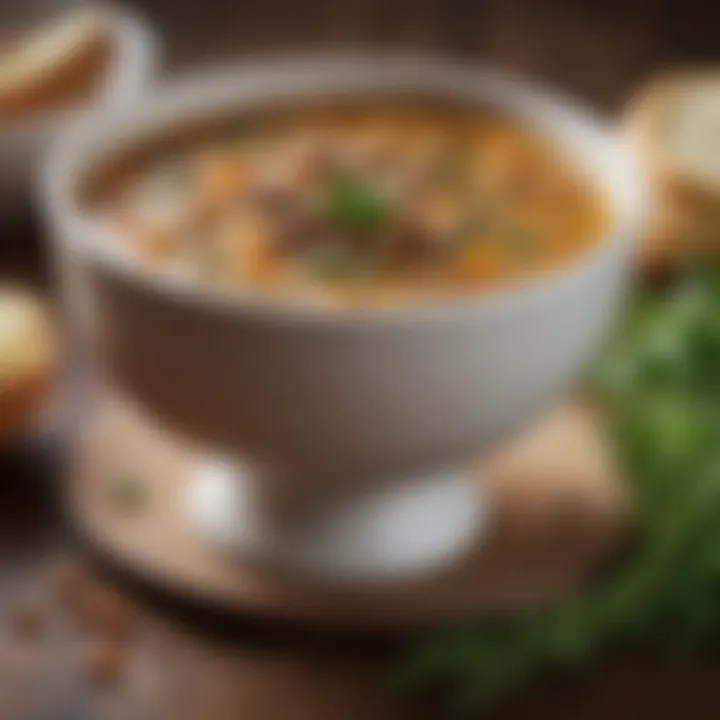Mastering Legumes: Essential Cooking Tips


Intro
Legumes form the backbone of many culinary traditions across the globe. Simple yet profound, they are packed with nutrition that benefits everyone—from the busy parent to the aspiring chef. Cooking with legumes is not just a meal choice but a lifestyle shift towards healthier eating. From the rich texture of lentils to the earthy flavors of chickpeas, these ingredients offer endless possibilities. This article embarks on a journey to demystify legumes, offering practical tips and creative recipes that will elevate your cooking. You might be surprised at how easy and rewarding it is to include legumes in your daily meals.
Since we’re diving into this vast world, let’s start with something special.
Recipe Highlight
- Enticing Name: Savory Chickpea Curry
- Essential Ingredients: 2 cups canned chickpeas, 1 onion, 2 cloves garlic, 1 inch ginger, 1 can coconut milk, 2 tablespoons curry powder, salt, and pepper to taste.
- Estimated Time: 30 minutes
- Servings: 4
Stepping into this culinary adventure, the Savory Chickpea Curry is a delightful dish that's perfect for beginners and seasoned cooks alike. It’s not only quick to prepare but also magnificent in flavor, marrying spices and richness with ease.
Step-by-Step Instructions
- Prepare Ingredients: Start by chopping the onion, garlic, and ginger finely. This base leads to an aromatic explosion in your dish.
- Cook Aromatics: In a large pan over medium heat, add a splash of oil. Once hot, toss in the onion. Sauté until golden brown, about 5 minutes.
- Add Garlic and Ginger: Introduce the garlic and ginger. Stir for 1-2 minutes until fragrant. If you let it go longer, it might burn and spoil the flavor.
- Spice It Up: Sprinkle in curry powder. Stir it well to blend with the aromatics. The heat will release the spices' oils, deepening the flavor.
- Mix in Chickpeas and Coconut Milk: Pour in the chickpeas and coconut milk. Stir that pot until everything is combined nicely. This is where the rich, creamy texture emerges.
- Simmer: Reduce heat and let it simmer for 15 minutes. Stir occasionally to prevent sticking.
- Season: Taste and add salt and pepper as needed.
- Serve: Enjoy with your favorite grain or bread and garnish with cilantro if you like.
Remember: One common mistake is adding too much salt too early. Let the flavors meld, adjust seasoning towards the end.
Variations and Substitutions
- If chickpeas aren’t your thing, try using black beans or lentils as an alternative—each brings its own unique character to the pot.
- For a zestier dish, add a squeeze of lime juice when serving. It cuts through the creaminess beautifully.
- Pair it with basmati rice, quinoa, or even naan bread to create a satisfying meal.
Time-Saving Cooking Tips
- Chop all your ingredients before you start cooking. It saves time and reduces stress as you won’t be rushing.
- Consider using a food processor for chopping; it’s quick and gets the job done well.
- Make a larger batch and freeze portions for quick meals later in the week. Just reheat and savor the goodness.
Nutritional Information
- Calories per Serving: Approximately 300 calories
- Key Nutrients: Protein (13g), Fiber (7g), Fat (15g)—especially beneficial for heart health due to coconut milk.
- Diet Suitability: This meal is vegan and gluten-free, making it accessible for a wide range of dietary needs.
The world of legumes is truly rich and rewarding, capable of transforming not only meals but also lives. Embracing these ingredients means more than cooking; it’s about enjoying the journey of nourishment and health.
Prologue to Legumes
Legumes have carved out a notable place in culinary history. They are not only rich in flavor but also pack a punch when it comes to nutrients. As we embark on this journey into the world of legumes, understanding the fundamentals is key. Legumes, including beans, lentils, peas, and chickpeas, are a versatile category of food that can be used in a myriad of recipes.
In today’s fast-paced cooking culture, knowing how to effectively cook legumes opens up a treasure chest of options. They are inexpensive, filling, and an excellent source of protein for those looking to vary their diet or embrace plant-based meals.
When you include legumes in your diet, you not only diversify your meals but also support a healthier eating habit. Their adaptability means you can throw them into salads, soups, stews, or even use them as a meat substitute. In essence, mastering legumes can elevate your culinary skills while making nutrition accessible.
Understanding Legumes
Legumes have been a staple in many diets worldwide for centuries. Their ability to nurture the soil while providing sustenance makes them unique. Simply put, a legume is a plant in the family Fabaceae, or the fruit or seed from that plant. Beans, lentils, chickpeas—they're all part of this family.
One main feature that sets legumes apart is their nitrogen-fixing capability. This means they can enrich the soil with nitrogen, a nutrient that’s vital for plant growth. From a culinary standpoint, legumes are celebrated not just for practicality, but also their health benefits.
Nutritional Benefits
When it comes to nutritional value, legumes stand tall. They are often loaded with fiber, which can aid digestion and ensure you feel fuller for longer. A well-known benefit of legumes is their partnership with heart health. Regularly consuming these tiny powerhouses can contribute to lowering cholesterol levels and managing blood pressure.
For those who are keen on keeping their diet wholesome, adding legumes provides a variety of vitamins and minerals. Iron, potassium, and magnesium are just a few examples of what legumes have to offer. Plus, they are low in fat, making them an excellent choice for anyone looking to maintain or lose weight.
Types of Legumes
Understanding the different types of legumes can help you make better decisions in the kitchen. Each type has unique traits that can influence not just flavor but also the texture of your final dish.
Dried Beans
Dried beans are a classic choice in many households. They can live up to their namesake, lasting for years in a pantry if stored correctly. One notable characteristic is their ability to absorb flavors exceptionally well when cooked. Beans, such as kidney or black beans, can take on the essence of spices and ingredients they are combined with.
A signature feature of dried beans is their variety; the vast array available means these can fit into almost any cuisine from chili in the U.S. to feijoada in Brazil. However, one must consider the soaking time required before cooking, which can be cumbersome for some.
Lentils
Lentils, often quicker to cook than beans, are popular for those pressed for time. These tiny discs cook relatively fast without the need for soaking, making them a go-to for weeknight meals. The ease of cooking lentils makes them appealing to busy cooks or those just beginning to experiment in the kitchen.
A key characteristic of lentils is their earthy flavor, which can blend well in salads, soups, or even served as a side dish. Their unique feature is the low level of carbohydrates compared to other legumes, making them an attractive option for health-conscious individuals.
Peas


Peas are perhaps the most accessible legume for beginners. Often found in frozen form, they require minimal cooking and add a delightful sweetness to dishes. Green peas, in particular, contain a wealth of vitamins and can be a simple compliment to mains or a base for purees.
An interesting feature of peas is their relatively high sugar content, which means they should be cooked just right to maintain texture. They can overcook easily, leading to a mushy consistency that can dampen the joy of a meal.
Chickpeas
Chickpeas, or garbanzo beans, are perhaps most recognized for their role in hummus and falafel. Their nutty taste and buttery texture allow them to shine in both savory and sweet dishes. A popular characteristic of chickpeas is their ability to absorb spices, enhancing a dish's flavor profile significantly.
Notably, chickpeas can be cooked relatively quickly, and the process of roasting them has gained popularity, allowing them to be used in salads or as snack food. However, they can be somewhat bland when not seasoned well, highlighting the importance of flavor balance.
Soybeans
Soybeans are the powerhouse legume packed with protein - often the go-to for vegans and vegetarians alike. Their versatility is on display in forms like tofu, tempeh, and soy milk. A striking characteristic of soybeans is their complete protein status, meaning they contain all nine essential amino acids. This makes soy a coveted protein source for many.
The unique attribute of soybeans includes their ability to be fermented, creating probiotic-rich foods that can aid digestion. But it’s worth noting that some people might be sensitive to soy, making it a potential allergen for others.
Preparation Techniques for Legumes
Preparing legumes the right way is crucial for bringing out their flavors and delivering a satisfying texture. Techniques used for preparing these nutrient-packed seeds can greatly affect their taste, cooking time, and health benefits. Knowing how to soak, cook, and store legumes properly ensures that they are not only palatable but also easy to digest. Here, we will break down soaking methods and cooking methods to help you master the art of cooking legumes.
Soaking Methods
Traditional Soaking
The traditional soaking method involves soaking legumes overnight or for a minimum of 8-12 hours. This method hydrates the beans, reducing their cooking time significantly. One of the key characteristics of this approach is how it softens the beans, making them more tender once cooked. It’s a popular choice among home cooks because it can even enhance the flavors. The unique feature here is that it allows the legumes to swell, which often leads to a creamier consistency in soups or stews.
The upside? Well, less time spent cooking means more flavor is absorbed from added seasonings. However, if you forget to soak them, this method can be a hurdle for those looking for a quick meal.
Quick Soaking
A quick soaking method comes into play when you're short on time. It involves boiling the legumes in water for about 1-2 minutes, then letting them sit, covered, for an hour. The appeal of quick soaking lies in its efficiency; it’s practical for those unexpected dinner plans. The key characteristic here is that it still makes for easier cooking while taking mere minutes instead of hours.
This method retains a fair amount of flavor absorption but may not yield as soft a texture as traditional soaking. A downside is that some people feel this method compromises the taste slightly when compared to the overnight soak.
No Soak Method
The no soak method is a game changer for many. It’s straightforward: just toss the dried legumes into your pot and cover them with water. You can simply cook them longer—typically 1.5 to 2 times longer than usual. This technique is increasingly popular among busy cooks, as it cuts prep time considerably. One key advantage is how it minimizes advance planning; you can always add legumes on a whim without worrying about soaking time.
However, the texture might not reach the levels achieved with other methods, and certain legumes like chickpeas may still need longer to soften.
Cooking Methods
Boiling
Boiling is one of the most straightforward and timeless methods for cooking legumes. You simply bring water to a rolling boil, add the prepped legumes, and let them simmer until tender. This method is beneficial because, for the most part, you can monitor the progress easily and add seasonings late in the process for more pronounced flavors. A unique aspect of boiling is its versatility; it works well for all types of legumes.
However, one must be careful not to over-boil, as this can lead to mushy results. And while it’s easy to do, it can cause flavor loss if done improperly.
Pressure Cooking
Pressure cooking has gained a lot of traction as a swift method for preparing legumes. This method uses high pressure to cook the legumes much faster than conventional boiling—sometimes in a fraction of the time. The key characteristic is intense heat retention which helps maintain nutrients, locking in flavors beautifully.
However, this method requires a bit of finesse; using too much heat or pressure can lead to undesirable mushiness. Once you're comfortable using a pressure cooker, it can be a time-saver unlike any other in a busy kitchen.
Slow Cooking
Slow cooking is the relaxation method for legumes. This is where flavors meld together seamlessly over low heat for several hours. Favoring slow cooking not only accentuates the taste but also tenderizes the beans to perfection. The underlying beauty of this technique is that you can throw everything into a crockpot and let it do its thing while you get on with your day.
Yet, one should be mindful that slow cooking requires planning. Leaving legumes all day without checking can lead to overcooking, and the waiting time may not suit those in a hurry.
Microwaving
Last but not least is microwaving—a method often underestimated when it comes to cooking legumes. This very method speeds up cooking time significantly and can be ideal for those who don’t want to dirty a lot of dishes. You cover your legumes with water in a microwave-safe dish and cook them until tender.
While it’s quick, not every legume reacts well to this method, and one might find uneven cooking or tough textures in some cases. Proper timing is essential, making it a bit tricky for newcomers.
Each method of preparation has its unique perks and downfalls, and understanding these can help you achieve the best results with legumes in your culinary journey.
Flavor Enhancements


When cooking with legumes, flavor enhancements play a pivotal role. The intrinsic flavor of legumes is often mild, which allows them to absorb the characteristics of ingredients surrounding them. This quality provides countless opportunities to experiment with various flavors and create mouthwatering dishes. Elevating legumes through thoughtful use of herbs, spices, and cooking liquids can transform a simple meal into a culinary delight.
Herbs and Spices
Seasoning Techniques
Seasoning techniques are fundamental when cooking legumes, as they impact the overall taste and aroma of the dish. An effective seasoning method marries the spices to the legumes, allowing for a harmony of flavors. It often involves layering spices at different stages of cooking, which enhances taste complexity. For example, adding garlic, cumin, and paprika early on can impart a deeper flavor profile. This timing is crucial—not just throwing all the spices in at once can yield subpar results.
One important aspect of seasoning legumes is the use of salt. Adding it too early can sometimes hinder the cooking process, making legumes more firm. Instead, waiting until the last stages of cooking to add salt can lead to tender, perfectly seasoned beans or lentils.
The use of fresh herbs like parsley, cilantro, or thyme in the final moments gives a fresh burst that brings vibrancy and brightness to the dish. Incorporating a variety of techniques gives versatility, allowing cooks to tailor the dish to specific palates or occasions.
Infusions with Aromatics
Infusing legumes with aromatics enriches their flavor significantly. Aromatics like onions, garlic, and ginger can make a world of difference. They serve not only to flavor but also to create an overall fragrant atmosphere while cooking. When sautéed before adding legumes, these ingredients release their natural oils and flavors, forming a robust base that permeates the legumes as they cook.
The technique of infusing also carries with it unique benefits. The subtle sweetness of caramelized onions, for example, melds beautifully with the earthy taste of lentils, leading to a well-rounded flavor. This method can be linked with various cuisines, showcasing how different cultures utilize aromatics to enhance legume dishes. However, one must be cautious not to overpower the natural taste of the legumes themselves, aiming instead for a balance that respects and complements.
Cooking Liquids
Broths and Stocks
Using broths and stocks as a cooking liquid for legumes provides a significant leap in flavor. A good quality vegetable or chicken broth infuses the legumes with rich taste as they absorb the liquid during cooking. The method is particularly effective when making soups or stews, as the legumes soak in both the liquid and the flavors of any additional ingredients.
When choosing a broth, homemade is often favored, as it can be tailored perfectly to your taste preferences. However, store-bought options can still provide an excellent flavor base and are convenient for quick meals. One downside is the sodium content in many commercial broths; checking nutritional labels ensures you maintain a healthy balance in your dish.
With broth as a base, you might also explore the idea of adding nutritional yeast or miso to deepen the umami flavor profile, offering complexity to an otherwise straightforward recipe.
Acidic Ingredients
Introducing acidic ingredients such as tomatoes, vinegar, or lemon juice can be transformative. Acidity cuts through the richness and adds brightness to a dish, making the flavors pop. Adding a splash of vinegar at the end of cooking can elevate the overall enjoyment by refreshing the palate. Acidic ingredients also help enhance the color and appeal of the dish, making it visually enticing.
One unique feature of using acidic components is that they can balance out the earthiness of legumes. However, it’s crucial to be mindful of timing; adding them too early can affect the cooking process and texture. For instance, introducing tomatoes too soon can prevent beans from softening properly, as tomatoes contain acids that can toughen the bean skins.
Choosing the right enhancements can lead to legume dishes that not only satisfy hunger but also provide a delightful culinary experience. By digging deeper into spices, aromatics, cooking liquids, and acids, one can truly master the potential of legumes in the kitchen.
Storage and Shelf Life
Understanding how to store legumes properly is essential to enjoying their numerous benefits while ensuring their longevity. Legumes, being rich in proteins and essential nutrients, can be a vital component of a well-rounded diet. However, improper storage can lead to spoilage or loss of quality over time. Knowing the ins and outs of storage not only helps in preserving their flavor and nutritional value but also aids in effective meal planning, especially in busy lifestyles.
Storing Dried Legumes
Dried legumes are an incredible staple, lasting for quite a long time when stored correctly. To keep them fresh, it's best to place them in an airtight container. Glass jars or plastic storage bins work wonders, but make sure they are absolutely dry before adding the legumes.
- Keep them in a cool, dark place. The pantry is often ideal, free from heat sources like ovens or direct sunlight.
- Label and date your containers. This helps to track how long they’ve been stored and ensure you’re using the oldest stock first.
- Check for pests. Inspect periodically, as dried legumes can sometimes attract unwanted insects. Toss any that look suspicious or show signs of infestation.
Storing them wisely not only extends their shelf life but also ensures that you have the best quality legumes at hand whenever you're ready to cook.
Storing Cooked Legumes
Once you cook your legumes, it's critical to adopt proper storage practices to enjoy their rich flavors and texture later on.
Refrigeration Tips
When it comes to refrigeration, the main rule of thumb is to cool cooked legumes within two hours of cooking. This minimizes the potential for bacterial growth. Place them in a shallow container, which allows them to cool down faster.
- Store in an air-tight container. This keeps the moisture in while preventing any other odors in the fridge from altering the taste of your legumes.
- Label your container's date. Cooked legumes can be safely stored in the fridge for about 3 to 5 days, so keeping track helps you avoid waste.
- Consider portioning. If you have a big batch, it's smart to divide them into smaller quantities before refrigerating. This way, you can take out only what you need, avoiding frequent opening and closing of the container.
These refrigeration tips are a beneficial choice for anyone looking to maintain the taste and safety of their cooked legumes. They maximize the shelf life while ensuring that you can whip up healthy meals whenever you want.
Freezing Methods
Freezing is another fantastic way to extend the life of cooked legumes. It’s perfect if you plan to batch cook some meals over the weekend for use during the busy weekdays.
- Pre-cool before freezing. Make sure to allow the legumes to come to room temperature to avoid ice crystals forming, which can alter texture.
- Use freezer-safe bags or containers. These help in preventing freezer burn, which can ruin the taste and texture.
- Label and date. Know how long they’ve been in the freezer, as cooked legumes typically last around 3 to 6 months in there.
Freezing can be a popular choice since it allows you to keep healthy meals on hand without the need for daily cooking. Some may argue about texture changes upon thawing, but if done right, the flavor remains intact while offering convenience.
In summary, mastering the storage of both dried and cooked legumes can vastly enhance your cooking experience, making it more efficient while preserving their quality. Ensure to optimize your pantry and fridge strategies, resulting in delightful meals crafted with these nutritious gems.
Quick Meal Ideas
When it comes to cooking with legumes, efficiency is key. Quick meal ideas are a boon for busy cooks who still want to eat healthily without sacrificing flavor or nutrition. These legumes can transform staple dishes into exciting meals that cater to various palates, making meal prep a lot less daunting after a long day.
Salads and Bowl Recipes


Legumes add a hearty texture and substantial protein to salads and bowls, making them filling and enjoyable. Start by tossing cooked chickpeas or black beans with fresh veggies like bell peppers, cucumbers, and a sprinkle of feta cheese. Drizzle with a zesty vinaigrette, and you’ve got yourself a vibrant meal.
In bowls, combine cooked quinoa, lentils, and roasted vegetables for a colorful and nutrient-packed dish. Top with tahini dressing for a creamy finish. Experimenting with various combinations can keep your meals fresh and exciting.
Soups and Stews
Legumes shine in soups and stews, serving as the backbone of these comforting dishes. A classic minestrone, for instance, enriched by cannellini beans, becomes a hearty meal all on its own.
For those chillier evenings, preparing a warming lentil stew is an excellent choice. Slow-cooking lentils with vegetables allows the flavors to meld beautifully. The texture becomes wonderfully creamy, and it’s perfect for leftovers too, as it only gets better with time.
Main Dishes
Chili Variations
Chili is a crowd-pleaser, and incorporating legumes brings an extra layer of richness. Think black bean chili or white chicken chili with navy beans for something different. These variations not only provide fiber but also create a satisfying meal that’s incredibly versatile.
The key characteristic here is the adaptability—chili can be tweaked to suit different diets and flavor profiles. You can easily switch up spices, add veggies, or even whip up a vegan version without missing the satisfaction of a traditional savory chili.
Curry Ideas
Curry is a wonderful way to showcase legumes. With chickpeas being a popular star in various cultures, a chickpea curry yields a robust dish. Not only does it pack a punch in flavors, but it also allows for easy meal prep.
The unique feature of curry recipes is their ability to absorb flavors and spices, offering a dynamic taste experience. Using coconut milk can add creaminess while keeping the dish dairy-free. The ability to prepare curry in advance, letting it simmer on low heat, reveals its depth of flavor—even better the next day.
"Cooking with legumes is more than just preparing food; it's about creating meals that nourish and comfort."
These meal ideas not only cater to a busy lifestyle but also deliver on taste and nutrition, showing just how versatile legumes can be when integrated into our cooking.
Common Mistakes
When cooking with legumes, it's all too easy to stumble into missteps that can derail your otherwise well-intentioned culinary efforts. Recognizing common mistakes is crucial because each blunder can lead to less-than-desirable results, whether it's in texture, flavor, or overall enjoyment of the dish. Understanding these pitfalls not only enhances your cooking experience but also elevates the nutritional profile and versatility of legumes in your meals.
Overcooking and Texture Issues
One of the biggest traps you can fall into when cooking legumes is simply overcooking them. It's an all-too-frequent error, especially when using methods like boiling or slow cooking. Too much heat over too long a duration can transform your once vibrant legumes into mushy remnants of their former selves. For instance, lentils may start out firm and flavorful but can quickly become a bland, soupy mix if left unattended.
To avoid this mistake, it’s important to keep an eye on timing. Each type of legume has its own cooking time, and knowing this can save a lot of hassle. Dried chickpeas, for example, normally take about 2 to 3 hours, whereas red lentils may only take 15 to 20 minutes. When you feel legumes are tender yet still hold their shape, it's usually time to take them off the heat.
Flavor Imbalance
Flavor is the heartbeat of any good dish, and legumes, while nutritious, can sometimes lack excitement on their own. A common error is thinking that simply adding legumes to a pot will be enough to create a harmonious dish. If the seasoning is neglected, the end result can be a bland mess. Imagine whipping up a pot of black beans without so much as a pinch of salt or a sprig of thyme — it’s just asking for disappointment.
It’s wise to layer flavors throughout the cooking process. Start by sautéing onions, garlic, or spices before adding your legumes. Infuse the cooking liquid with herbs, spices, and aromatics to ensure that the legumes absorb an array of flavors. Think about using stocks instead of plain water, as they can enrich the overall taste immensely.
Neglecting Soaking or Cooking Time
Another aspect that can seriously impact your legume dish is not adhering to proper soaking or cooking times. This often happens with dried beans when home cooks skip the soaking process. While some argue that soaking isn't strictly necessary — especially with lentils or split peas — for tougher beans like kidney or pinto, a little pre-soak can make a world of difference in texture and cooking time.
If you decide to skip the soaking, just be prepared for a longer cooking time. Each legume demands its own attention: chickpeas need a hearty soak to ensure even cooking, while green peas don’t require much at all. A good rule of thumb is to always check recommended soaking times and adjust accordingly, which can dramatically influence both the texture and ease of cooking.
"A stitch in time saves nine" — paying attention to cooking and soaking times can save your dish from being a complete flop.
By avoiding these common mistakes, you can deliver delicious and satisfying meals that showcase the full culinary potential of legumes. From texture to flavor balance and proper soaking, each element plays a crucial role in the final outcome. With a little awareness, your legume dishes are sure to be a hit!
Legumes in Global Cuisine
Legumes have carved their niche not just as nutritional powerhouses but also as a canvas for cultural expression across the globe. Their extensive use in various cuisines shows how these humble ingredients can bridge cultural gaps. Incorporating legumes into everyday meals is a testament to their versatility, cost-effectiveness, and the ease with which they can enhance flavors. This section emphasizes the significance of legumes in global dishes while providing insight into how they can enrich modern cooking practices.
Culinary Uses Across Cultures
Every culture has its own sing-song rhythm of preparing legumes. In India, the aromatic dal is a staple; it's lentils simmered with spices like turmeric and cumin, resulting in a comforting, protein-rich dish. On the Mediterranean shores, dishes like hummus, made from chickpeas and tahini, have transcended borders and become a popular dip worldwide. Furthermore, consider cajun cooking, where red beans and rice become a beloved dish, showcasing how legumes can be a hearty and soul-satisfying meal.
Legumes thrive in various environments and culinary settings. From succotash in North America to feijoada in Brazil, their adaptability is remarkable. Here is a quick rundown of legume uses in different culinary contexts:
- Asian Cuisine: Mung beans in stir-fry and Chinese pancakes.
- African Cuisine: Black-eyed peas in hoppin' john, a celebratory dish.
- Middle Eastern Cuisine: Fava beans as the base of ful medames.
Legumes not only bring nutrition to the table but also the essence and history of the cultures they represent.
Incorporating Legumes into Modern Recipes
Modern cooking, fast-paced as it may be, welcomes legumes with open arms. Incorporating these ingredients into contemporary dishes often promotes both creativity and sustainability. Examples abound in home kitchens today: quinoa bowls topped with spiced lentils, or vegan tacos served with black beans mixed with lime and cilantro. As people lean towards healthier eating, understanding how to integrate legumes seamlessly can elevate a dish from ordinary to extraordinary.
Here are some straightforward ideas:
- Savory Breakfast Bowls: Start your morning with a bowl of aduki beans mixed with avocado and a poached egg.
- Smoothies with a Twist: Add red lentil powder to smoothies for a protein boost.
- Grain-Free Pasta Alternatives: Use chickpea flour to create your own fresh pasta.
Legumes are the backbone of many diets, combining nutritional substance with a rich culinary legacy.
While experimenting, it’s essential to consider cooking times and techniques to retain their quality. As they can absorb flavors like a sponge, pair them with various spices and cooking liquids for an unforgettable dish. With their ever-expanding role in global cuisines, legumes stand as a symbol of culinary versatility and community. Understanding their applications is not just about nutrition; it’s about connecting with cultures while enjoying delicious meals.







